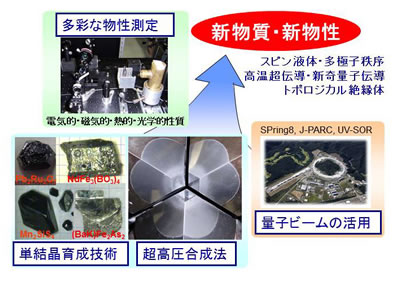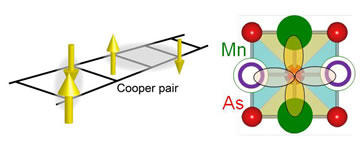Condensed Matter Experiment Ⅰ
Macroscopic Quantum Phenomena
http://web.tohoku.ac.jp/mqp/en/home/
Staff
| Professor : | Kenya Ohgushi | |||
| Associate Professor : | Yoshinori Imai | |||
| Assistant Professor : | Fumiya Hori |
Research


magnetic quadrupole order (right).
When a macroscopic number of electrons are strongly correlated with each other, a novel quantum state characterized by the symmetry breaking and/or topological anomaly frequently emerges. Examples include superconductivity, spin liquid, and quantum Hall effect. Elementary excitations from such quantum state are completely different from one electron itself. The central issue in the science of strongly correlated electron systems is to unravel what kind of quantum state is realized, what are elementary excitations, and what is the relationship between the quantum state and elementally excitations.
Among many known strongly correlated electron systems, we focus on transition metal compounds, which have three characteristic features. Firstly, the energy scale is relatively large. Therefore, quantum phenomena emerge at rather high temperature; the notable examples are high-Tc superconducting cuprates and room-temperature permanent magnets. Secondly, there are internal degrees of freedoms such as charge, spin, and orbital. This results in complex and versatile quantum orders, which are competing with each other in energy. Thirdly, a quantum phase inherent in a material plays a key role. The Berry phase science in the matter is now the hottest topic in the current condensed matter physics.
Our group’s research is focused on the exploratory synthesis and characterization of strongly correlated transition-metal compounds. We synthesize high-quality transition-metal compounds using a variety of techniques such as the flux, chemical vapor transport, and high-pressure methods. The electrical, magnetic, thermal, and optical properties of these compounds are then characterized. To investigate their crystal and magnetic structure, x-ray and neutron diffraction measurements are also carried out at external facilities such as SPring-8. By combining these wide varieties of techniques, we are questing for novel macroscopic quantum phenomena such as magnetic order, superconductivity, and topological order.
-
Particularly, we are now studying on the following topics.
- (1) Transport and optical properties of Fe-based superconductors.
- (2) Transport properties of odd-parity multipole ordered state.
- (3) Transport properties in strongly spin-orbit coupled 5d transition metal compounds.
- (4) Search for novel quantum materials using high-pressure synthesis.
- (5) Investigation of structural properties using quantum beams.

